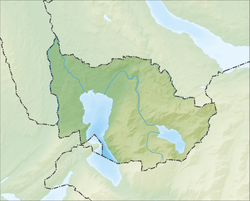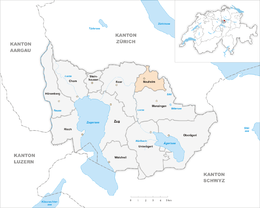Neuheim ZG
| Neuheim | ||
|---|---|---|
 |
||
|
||
| Coordinates: 47°12′N 8°35′E / 47.200°N 8.583°ECoordinates: 47°12′N 8°35′E / 47.200°N 8.583°E | ||
| Country | Switzerland | |
| Canton | Zug | |
| District | n.a. | |
| Area | ||
| • Total | 7.92 km2 (3.06 sq mi) | |
| Elevation | 666 m (2,185 ft) | |
| Population (Dec 2015) | ||
| • Total | 2,154 | |
| • Density | 270/km2 (700/sq mi) | |
| Postal code | 6345 | |
| SFOS number | 1705 | |
| Surrounded by | Baar, Hausen am Albis (ZH), Hirzel (ZH), Menzingen | |
| Website |
www SFSO statistics |
|
Neuheim is a municipality in the canton of Zug in Switzerland.
Neuheim is first mentioned in 1080 as Niuheim. In 1173 the parish church of St. Blasien was built and Neuheim became the center of the parish of Neuheim. The parish was originally part of Einsiedeln and in 1363 was transferred to Kappel Abbey. In 1512 the Abbey sold the rights to the parish income to the parish of Menzingen and also to the parish of Neuheim. Then, finally in 1675 the parish acquired complete rights to its income. Almost two centuries later, in 1848, the municipality joined the parish and became independent of Menzingen.
Neuheim has an area, as of 2006[update], of 8 km2 (3.1 sq mi). Of this area, 65.8% is used for agricultural purposes, while 18.1% is forested. Of the rest of the land, 14.3% is settled (buildings or roads) and the remainder (1.8%) is non-productive (rivers, glaciers or mountains).
The municipality is located in the moraine landscape between the Lorze and Sihl rivers. It shares the village of Sihlbrugg with Baar (ZG), Hausen am Albis (ZH), Hirzel (ZH). The village is part of an important transportation route between Zürich and the Innerschweiz (Central Switzerland).
Neuheim has a population (as of 31 December 2015) of 2,154. As of 2007[update], 17.3% of the population was made up of foreign nationals. Over the last 10 years, the population has grown at a rate of 3.7%. Most of the population (as of 2000[update]) speaks German (87.9%), with Serbo-Croatian being second most common (2.1%) and French being third (1.5%).
...
Wikipedia




